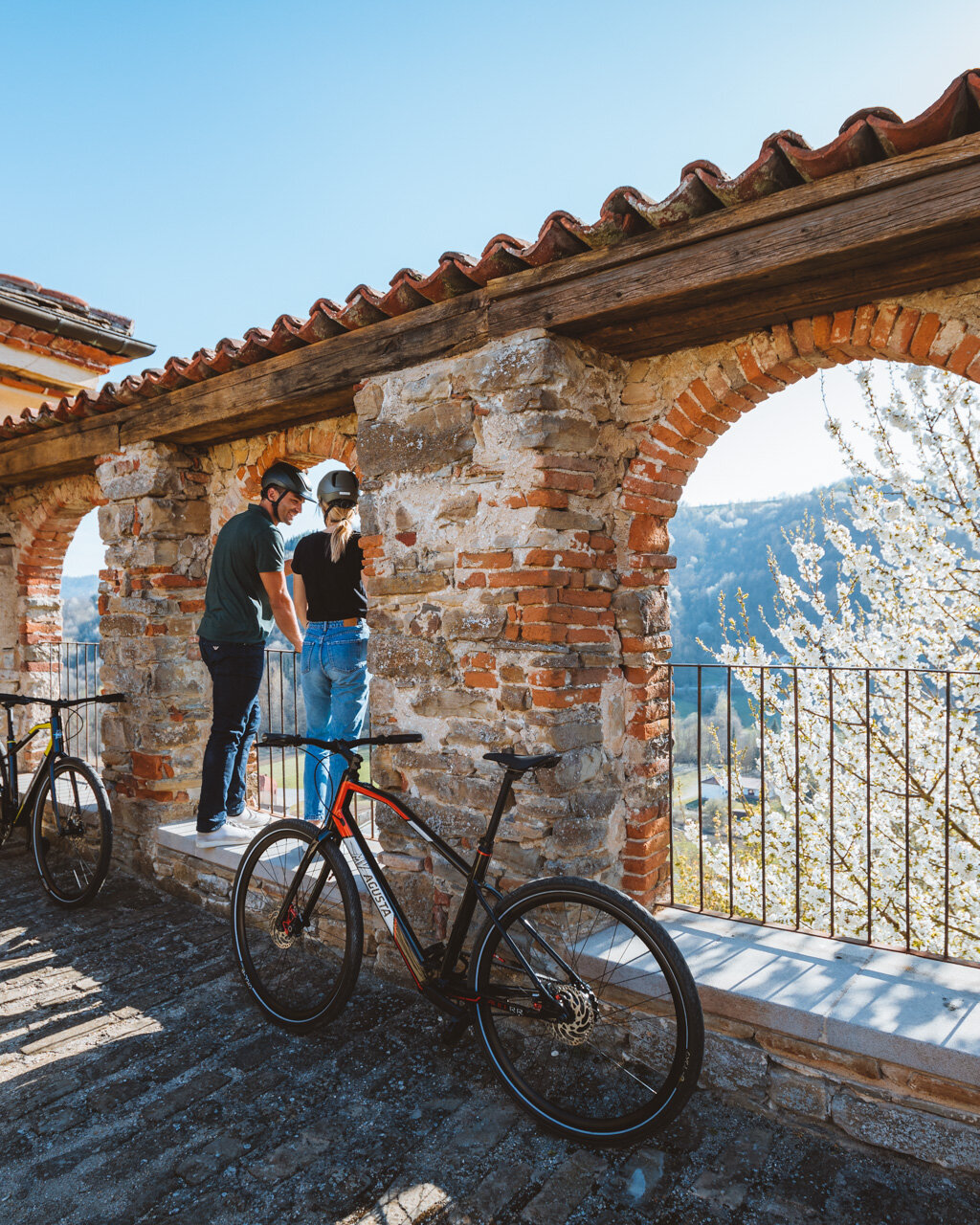The feature of small building (of the sort typically found in the middle of a field, once used by farmers as a tool shed or other shelter) is its unique tower shape, from which it gets its name torion. There is also a large hole in the side of the building, which was created by a bombing in 1944 during one of the battles between the resistance fighters and members of the Repubblica Sociale Italiana. From the parking lot, head up in the direction of Castagnito. After just a few metres, take Strada Varasca to your left. When you reach the buildings of a winemaker, turn right onto a flat road that soon turns to gravel. Continue along the flat, parallel to highway SP 29, through cultivated fields and hazelnut groves. You will then find orderly rows of poplar trees, which, in springtime, create a spectacular “snowfall” effect when the pappi fall from the trees and float through the air.
Keeping to the left, you will begin heading down towards the new industrial zone of Canale, as the trail runs alongside the main highway. When you get to a large roundabout, continue along the service road of several industrial buildings. Pass the cemetery and continue in the direction of the centre of town. Continue along Corso Asti until you reach Canale’s historic wine cellar Cantine Enrico Serafino, where Corso Asti meets Via Roma. Here, a long series of shop windows run down both sides of the town’s main street. The centre of town, with its orderly streets and porticoes along each side of the main street, maintains the typical villanova structure that the city of Asti established in 1260 for its neighboring settlements (including Anterisio, Loreto di Canale, Castelletto d’Astisio, the “old” Canale, and other minor settlements) after the defeat of the Biandrate Family. In 1379, dominion over Canale passed to the Roero Family and then gradually, beginning in 1512, shifted hands to the Malabaila Family, who inhabit the castle, with its park of old-growth trees, to this day.
Once you’ve reached Piazza della Vittoria, you’ll not want to miss a trip to Enoteca Regionale del Roero, the institutional wine centre that provides information for tourists about the winemakers in the Roero region. Here, you will find a lovely garden in the building’s inner courtyard, as well as a famous Michelin-starred chef on the upper floor. The 13th century Civic Tower, which you will pass along this route, is all that is left of this village’s outer wall.
The square of the Church of San Bernardino has remained essentially unchanged since the early 1900s, when it was entirely occupied by a daily peach market. In those days, due to a number of diseases that affected the vineyards, peaches became the dominant agricultural product and Canale became known internationally as a producer of quality peaches.
Today, there are far fewer peach groves than there once were, but a peach trade fair is still held here every July and a handful of art nouveau buildings with intriguing floral decor point to a period of economic boom for the entire town. One such building can be found at the start of Via Torino in the direction of Montà. From here, turn right when you come to signs for “Agriturismo Le Querce del Vareglio” and continue along a narrow road, which starts out paved and then turns to gravel, until you cross a small stream. Turn left here into the fields, then soon head up to the right to gradually climb the San Bartolomeo hillside (which gets its name from the shrine at its summit) through a myriad of hazelnut groves, vineyards, woods and cultivated fields. You will come across the trail S1, that here correspond to the “Sentiero del Castagno” (literally: “Trail of the Chestnut”, which you will follow in the opposite direction from what the signage indicates) in a section between the high walls of the Rocche, steep vineyards and areas in the shade of the surrounding vegetation.
When you reach the summit, continue on until you reach the Centro Outdoor Valle delle Rocche in San Grato di Montà. This mountain bike park is situated at the junction of four trails and features a MTB/XC circuit, a lighted pump track and a dual-slalom run with loads of kickers and berms. Here, you will also find a range of services for cyclists, including a self-serve workshop, bike wash, locker rooms and restrooms.
Leaving the bike park behind you, continue along Via Morra, a dirt road that runs along the crest of the hill in the direction of the hilltop village of Montà, with a panoramic vista over the area’s rock formations. Continue alongside the tranquil park of the 16th century Morra Lavriano Castle. When you reach Piazza di Sant’Antonio Abate with the village’s main church behind you, head down into the historical centre along Via Roma. You will pass the Civic Tower (circa 1754) on your left, which marks the start of the trail “Strada delle Masche” (Street of the Masche), a brief, panoramic stroll to a natural balcony overlooking the surrounding hills.
PLEASE NOTE: Responsibility for the maintenance and practicability of the various trails lies with the municipalities where the routes are located. The Tourist Board, therefore, cannot be held responsible for any inefficiencies, but is willingly available to collect your reports so that they can be forwarded to the authorities concerned.


